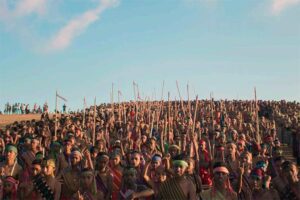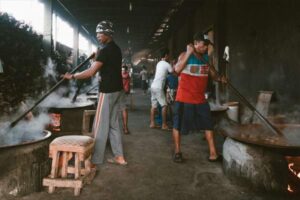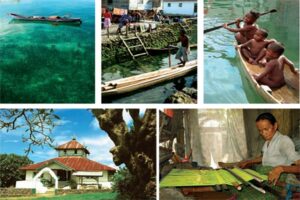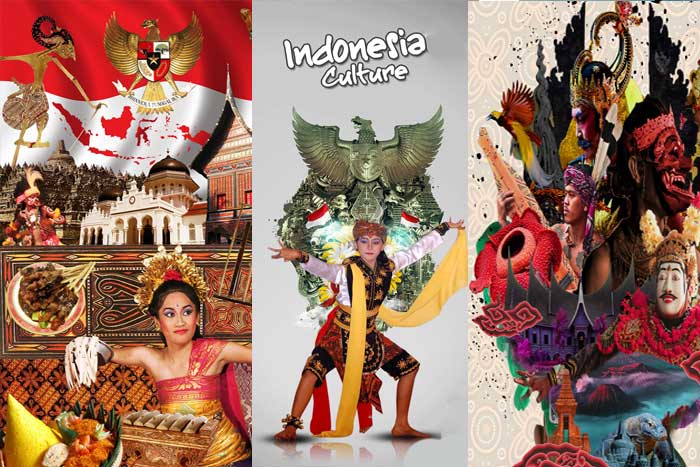
Indonesia has around 300 ethnic groups, each with cultural differences developed over centuries, and influenced by Arabic, Chinese, Malay, and European sources. Traditional Javanese and Balinese dances, for example, contain aspects of Hindu culture and mythology, as do wayang kulit (shadow puppet) performances. Textiles such as batik, ikat and songket are created across Indonesia in styles that vary by region.
The most dominant influences on Indonesian architecture have traditionally been Indian; however, Chinese, Arab, and European architectural influences have been significant. The most popular sports in Indonesia are badminton and football; Liga Indonesia is the country’s premier football club league. Traditional sports include sepak takraw, and bull racing in Madura.
In areas with a history of tribal warfare, mock fighting contests are held, such as, caci in Flores, and pasola in Sumba. Pencak Silat is an Indonesian martial art. Sports in Indonesia are generally male-orientated and spectator sports are often associated with illegal gambling.
A selection of Indonesian food, including Soto Ayam (chicken noodle soup), sate kerang (shellfish kebabs), telor pindang (preserved eggs), perkedel (fritter), and es teh manis (sweet iced tea)
A selection of Indonesian food, including Soto Ayam (chicken noodle soup), sate kerang (shellfish kebabs), telor pindang (preserved eggs), perkedel (fritter), and es teh manis (sweet iced tea)
Indonesian cuisine varies by region and is based on Chinese, European, Middle Eastern, and Indian precedents. Rice is the main staple food and is served with side dishes of meat and vegetables. Spices (notably chili), coconut milk, fish and chicken are fundamental ingredients. Indonesian traditional music includes gamelan and keroncong. Dangdut is a popular contemporary genre of pop music that draws influence from Arabic, Indian, and Malay folk music. The Indonesian film industry’s popularity peaked in the 1980s and dominated cinemas in Indonesia, although it declined significantly in the early 1990s.[118] Between 2000 and 2005, the number of Indonesian films released each year has steadily increased.
The oldest evidence of writing in Indonesia is a series of Sanskrit inscriptions dated to the 5th century CE. Important figures in modern Indonesian literature include: Dutch author Multatuli, who criticized treatment of the Indonesians under Dutch colonial rule; Sumatrans Muhammad Yamin and Hamka, who were influential pre-independence nationalist writers and politicians; and proletarian writer Pramoedya Ananta Toer, Indonesia’s most famous novelist. Many of Indonesia’s peoples have strongly-rooted oral traditions, which help to define and preserve their cultural identities. Media freedom in Indonesia increased considerably after the end of President Suharto’s rule, during which the now-defunct Ministry of Information monitored and controlled domestic media, and restricted foreign media. The TV market includes ten national commercial networks, and provincial networks that compete with public TVRI. Private radio stations carry their own news bulletins and foreign broadcasters supply programs. At a reported 18 million users in 2005, Internet usage is limited to a minority of the population.
Wayang Kulit
Wayang is an Indonesian word for theatre. When the term is used to refer to kinds of puppet theater, sometimes the puppet itself is referred to as wayang. “Bayang”, the Javanese word for shadow or imagination, also connotes “spirit.” Performances of shadow puppet theater are accompanied by gamelan in Java, and by “gender wayang” in Bali.
UNESCO designated Wayang Kulit, a shadow puppet theater and the best known of the Indonesian wayang, as a Masterpiece of Oral and Intangible Heritage of Humanity on 7 November 2003.
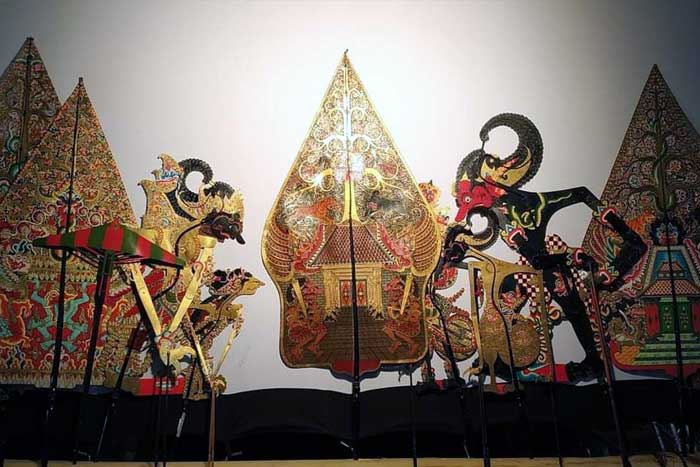
History of Wayang
Wayang is a generic term denoting traditional theatre in Indonesia. There is no evidence that wayang existed before Hinduism came to southeast Asia sometime in the first century CE. However, there very well may have been indigenous storytelling traditions that had a profound impact on the development of the traditional puppet theatre. The first record of a wayang performance is from an inscription dated 930 CE which says “si Galigi mawayang,” or “Sir Galigi played wayang”. From that time till today it seems certain features of traditional puppet theatre have remained. Galigi was an itinerant performer who was requested to perform for a special royal occasion. At that event we know he performed a story about the hero Bima from the Mahabharata.
Hinduism arrived in Indonesia from India even before the Christian era, and was slowly adopted as the local belief system. Sanskrit became the literary and court language of Java and later of Bali. The Hindus changed the Wayang (as did the Muslims, later) to spread their religion, mostly by stories from the Mahabharata or the Ramayana. Later this mixture of religion and wayang play was praised as harmony between Hinduism and traditional Indonesian culture. On Java, the western part of Sumatra and some smaller islands traditionalists continued to play the old stories for some time, but the influence of Hinduism prevailed and the traditional stories either fell into oblivion or were integrated into the Hinduistic plays.
The figures of the wayang are also present in the paintings of that time for example the roof murals of the courtroom in Klungkung, Bali. They are still present in traditional Balinese painting today.
When Islam began spreading in Indonesia, the display of God or gods in human form was prohibited, and thus this style of painting and shadow play was suppressed. King Raden Patah of Demak, Java wanted to see the wayang in its traditional form, but failed to obtain permission from the Muslim religious leaders. As an alternative, the religious leaders converted the wayang golek into wayang purwa made from leather, and displayed only the shadow instead of the figures itself. Instead of the forbidden figures only their shadow picture was displayed, the birth of the wayang kulit.
The wayang klitik figures are painted, flat woodcarvings (a maximum of 5 to 15 mm thick — barely half an inch) with movable arms. The head is solidly attached to the body. With these, it is possible to do puppet plays either by day or by night. This type of wayang is relatively rare.
Wayang today is both the most ancient and most popular form of puppet theatre in the world. Hundreds of people will stay up all night long to watch the superstar performers, dalang, who command extravagant fees and are international celebrities. Some of the most famous dalang in recent history are Ki Nartosabdho, Ki Anom Suroto, Ki Asep Sunarya, K
Indonesia Batik
Batik (Javanese-Indonesian pronunciation: [bate], is an Indonesian word and refers to a generic wax-resist dyeing technique used on textile. The word originates from Javanese word “amba”, meaning ”to write” and the Javanese word for dot or point, “titik.” Batik, A String of Beautiful Dots
It is known to be more than a millennium old, probably originating in ancient Egypt or Sumeria. There is evidence that cloth decorated through some form of resist technique was in use in the early centuries AD. [citation needed] It is found in several countries later in West Africa such as Nigeria, Cameroon and Mali, or in Asia, such as India, Sri Lanka, Bangladesh , Iran, Thailand, and Malaysia, but the most popular are in Indonesia.
Ikat Weaving of Indonesia
Ikat, or Ikkat, is a style of weaving that uses a resist dyeing process similar to tie-dye on either the warp or weft before the threads are woven to create a pattern or design. A Double Ikat is when both the warp and the weft are tie-dyed before weaving.
Ikat means “to tie” or “to bind” in the Malay language and has the same root as the words dekat (“close”), lekat (“to stick”), pikat (“to catch”) etc. The word Katt has the same meaning in all of the south Indian languages but there may be no relation. Through common usage, the word has come to describe both the process and the cloth itself. Ikats have been woven in cultures all over the world. In Central and South America, Ikat is still common in Argentina, Bolivia, Ecuador, Guatemala and Mexico. In the 19th century, the Silk Road desert oases of Bukhara and Samarkand (in what is now Uzbekistan in Central Asia) were famous for their fine silk Uzbek Ikat. India, Japan and several South-East Asian countries have cultures with long histories of Ikat production. Double Ikats can still be found in India, Guatemala, Japan and the Indonesian islands of Bali and Kalimantan.
Songket Weaving of Indonesia
Like any craft or art form, ikats vary widely from country to country and region to region. Designs may have symbolic of ritual meaning or have been developed for export trade. Ikats are often symbols of status, wealth, power and prestige. Perhaps because of the difficulty and time required to make ikats, some cultures believe the cloth is imbued with magical powers.
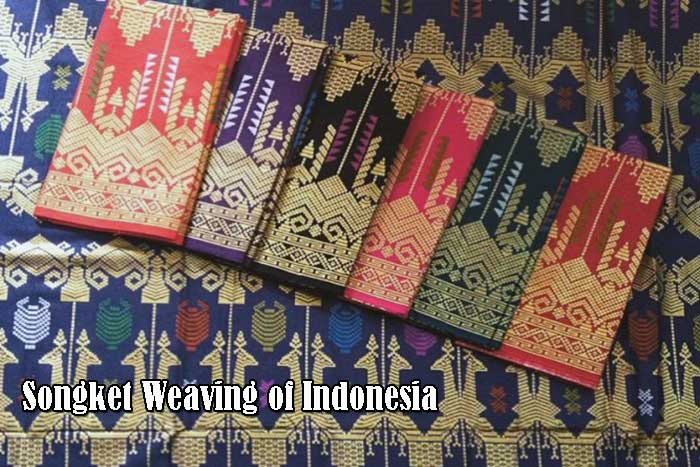
Songket is a fabric that belongs to the brocade family of textiles. It is hand-woven in silk or cotton, and intricately patterned with gold or silver threads. The metallic threads stand out against the background cloth to create a shimmering effect. In the weaving process the metallic threads are inserted in between the silk or cotton weft (latitudinal) threads. The term songket comes from the Malay word menyongket, ‘to embroider with gold or silver threads’. Songket is a luxury product traditionally worn during ceremonial occasions as sarong, shoulder cloths or head ties. Tanjak or Songket headdresses were worn at the courts of the Malay Sultanates. Traditionally Muslim women and adolescent girls wove songket; “some boys and men are also weaving today”. Traditionally-patterned Sumatran textiles embody a system of interpretable emblems.
In Indonesia, songket is produced in Sumatra, Kalimantan, Bali, Sulawesi, Lombok and Sumbawa. Outside of Indonesia, further production areas include the east coast of the Malay Peninsula and Brunei. Songket weaving is historically associated with areas of Malay settlement, and the production techniques could have been introduced by Arab and Indian merchants. Historically, production was located in politically significant kingdoms because of the high cost of materials; the gold thread used was originally wound with real gold leaf.
Indonesian Architecture
Indonesian Architecture reflects the same diversity of cultural, historical, and geographic influences that have shaped Indonesia as a whole. Invaders, colonisers, missionaries, merchants and traders brought cultural changes that had a pronounced effect on building styles and techniques. Traditionally, the most significant foreign influence has been Indian, however Chinese, Arab—and since the 18th and 19th centuries—European influences have been important.
At a Glance About Indonesia Culture



